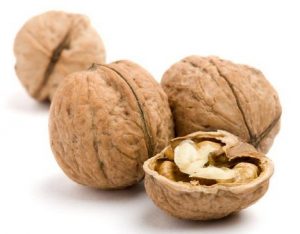How to Grow Walnuts – A Guide to Growing Walnuts
 Walnuts will begin to produce fruit after about four years. To obtain a good crop, most varieties will need a pollinator of a different variety as the male and female flowers grow together on a single tree but tend to be in bloom at different times.
Walnuts will begin to produce fruit after about four years. To obtain a good crop, most varieties will need a pollinator of a different variety as the male and female flowers grow together on a single tree but tend to be in bloom at different times.
Wear gloves when you’re handing the nuts, whether harvesting or preparing for preserving – walnuts produce a permanent dye – the resulting stain on your skin is just about impossible to remove.
Growing Walnuts
- Pot grown trees can be planted at any time of year, but it is best to plant during the dormant period in winter as long as the soil is not frozen or water-logged; bare rooted trees should be planted late autumn–early spring.
- Walnuts are best planted in well-drained but moisture-retentive, deep soil in full sun or light shade. They prefer an alkaline soil. Avoid planting in a frost pocket as a late frost will damage any early buds.
- You will find both bare-rooted and pot grown trees available to buy.
- When you plant, ensure that the visible soil line at the foot of the tree is just above the level of the soil.
- Dig a hole large enough to comfortably accommodate the depth and size of the roots. Firm in and water in well after planting.
- Remove any vegetation around the base of the tree and mulch well, to help keep in the moisture and discourage weeds, etc, growing and competing with the young tree.
- While you should not let your young tree dry out during the first year or two, don’t let it get waterlogged as this can cause rot in walnut trees.
- Feed with a general all-purpose fertiliser in early spring.
- Prune in mid-winter or mid-summer.
Harvesting Walnuts
- The nuts can be picked from the tree June–July while still ‘green’ (before the shells have developed) and pickled – a long broom handle is a help in gently knocking them off the tree.
- Otherwise, wait until they start to fall and the husks split. Collect and place in a single layer, in a warm, airy-place to dry out. The green husks will completely split, revealing the walnuts.
Pests and Problems with Walnuts
- Protect the young trees from deer and rabbits, which will strip the bark from the trees.
- Squirrels will happily take the nuts.
Varieties of Walnut
- There are many named varieties available.
- To obtain a good crop of walnuts, most varieties (even those sold as self-fertile) will need a pollinator of a different variety as although the male and female flowers grow together on a single tree, they tend to bloom at different times.
Eating
- Young, immature walnuts (picked in the summer) can be pickled in vinegar (read our article on pickling), or remove the mature nuts from their husks and preserve in a sugar syrup. They are also suitable for freezing.
- Walnuts will store in their shell in a cool, dry place, for a few months.
- We have several chutney recipes using walnuts.



